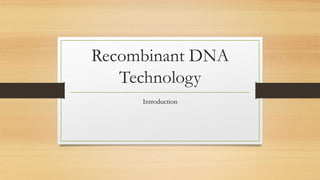
introduction RDNA.pptx
- 2. Itroduction • It emerged in the year 1968, with the discovery of restriction enzymes by Swiss microbiologist Werner Arber. • The technology used for producing artificial DNA through the combination of different genetic materials (DNA) from different sources is referred to as Recombinant DNA Technology. • Recombinant DNA technology is popularly known as genetic engineering.
- 3. Some Terms • Recombinant DNA: Single chimeric DNA formed by combining two or more different fragments of DNA from diverse organisms is generally called as recombinant DNA. • Host Organism: The organism used for propagation or expression of recombinant DNA is known as host organism. • Vector: Vector is an autonomously replicating (inside a host cell) DNA molecule designed from a plasmid or phage DNA to carry a foreign DNA inside the host cell.
- 4. Molecular cloning is a process for creating recombinant DNA and generally involves the following steps: • (1) Selection of a cloning vector • (2) Selection of a host organism • (3) Preparation of a vector DNA • (4) Preparation of DNA to be cloned • (5) Creation of recombinant DNA vector (having foreign DNA) • (6) Introduction of recombinant vector into host organism • (7) Selection of clones having insert vector. • (8) Screening and multiplication of recombinant clones with desired DNA inserts.
- 5. Overview
- 6. A good host should have the following properties: • • Easy to grow and transform. • • Do not hinder replication of recombinant vector. • • Do not have restriction and methylase activities. • • Deficient in recombination function so that the introduced recombinant vector is not altered. • • Easily retrievable from the transformed host.
- 7. Various hosts are used in rDNA technology depending on the goal: For example bacteria, yeast, plant cells, animal cells, whole plants and animals. Prokaryotic systems such as E. coli are commonly used due to various advantages like, they have well studied expression system, Compact genome, Versatile, Easy to transform, Widely available, and Rapid growth of recombinant organisms with minimal equipment. • Only disadvantage is that they lack post-translational modification (PTMs) machinery required for eukaryotic proteins. Eukaryotic systems are difficult to handle in contrast to bacterial hosts. • They are favoured for expression of recombinant proteins which require post translational modification and only if they can grow easily in continuous culture.
- 8. A good vector should have the following characteristics: • • Autonomously replicating i.e. should have ori (origin of replication) region. • • Contain at least one selectable marker e. g. gene for antibiotic resistance. • • May contain a scorable marker (β-galactosidase, green fluorescent protein etc.) • • Presence of unique restriction enzyme site. • • Have multiple cloning sites. • • Preferably small in size and easy to handle. • • Relaxed control of replication to obtain multiple copies. • • Presence of appropriate regulatory elements for expression of foreign gene. • • High copy number
- 9. Preparation of recombinant DNA Mainly three methods are used to prepare recombinant DNA: • 1. Transformation • 2. Non- bacterial transformation/transfection • 3. Phage introduction/transduction
- 10. Transformation: • Transformation is direct uptake of exogenous DNA via cell membrane leading to incorporation into the host DNA. • It is commonly occurred in bacteria. • Transformation requires different tools of molecular biology to insert foreign DNA into the host. • For example, vector to carry the foreign DNA to the host; restriction enzymes to cut the DNA in specific site; ligase to join two DNA molecule etc.
- 11. Non-bacterial transformation/transfection: • The process of foreign DNA uptake by host cell driven by mechanical or chemical factors is classified under non-bacterial transformation, also termed as transfection. • Different methods of non-bacterial transformation are microinjection, liposome mediated transformation, biolistics etc.
- 12. Phage introduction/transduction: • Phage vector is used to carry and replicate foreign DNA inside the bacterial host system. The phage DNA inserts into the host chromosome by recombination. • Phage λ had short regions of single-stranded DNA with complementary base sequences called “cohesive” (cos) sites. Base pairing between the complementary cos sites allows the linear genome to form a circle within the host bacterium. • Circularized viral genome can be integrated into the bacterial genome by homologous recombination between attP site of viral genome and attB site of bacterial genome.